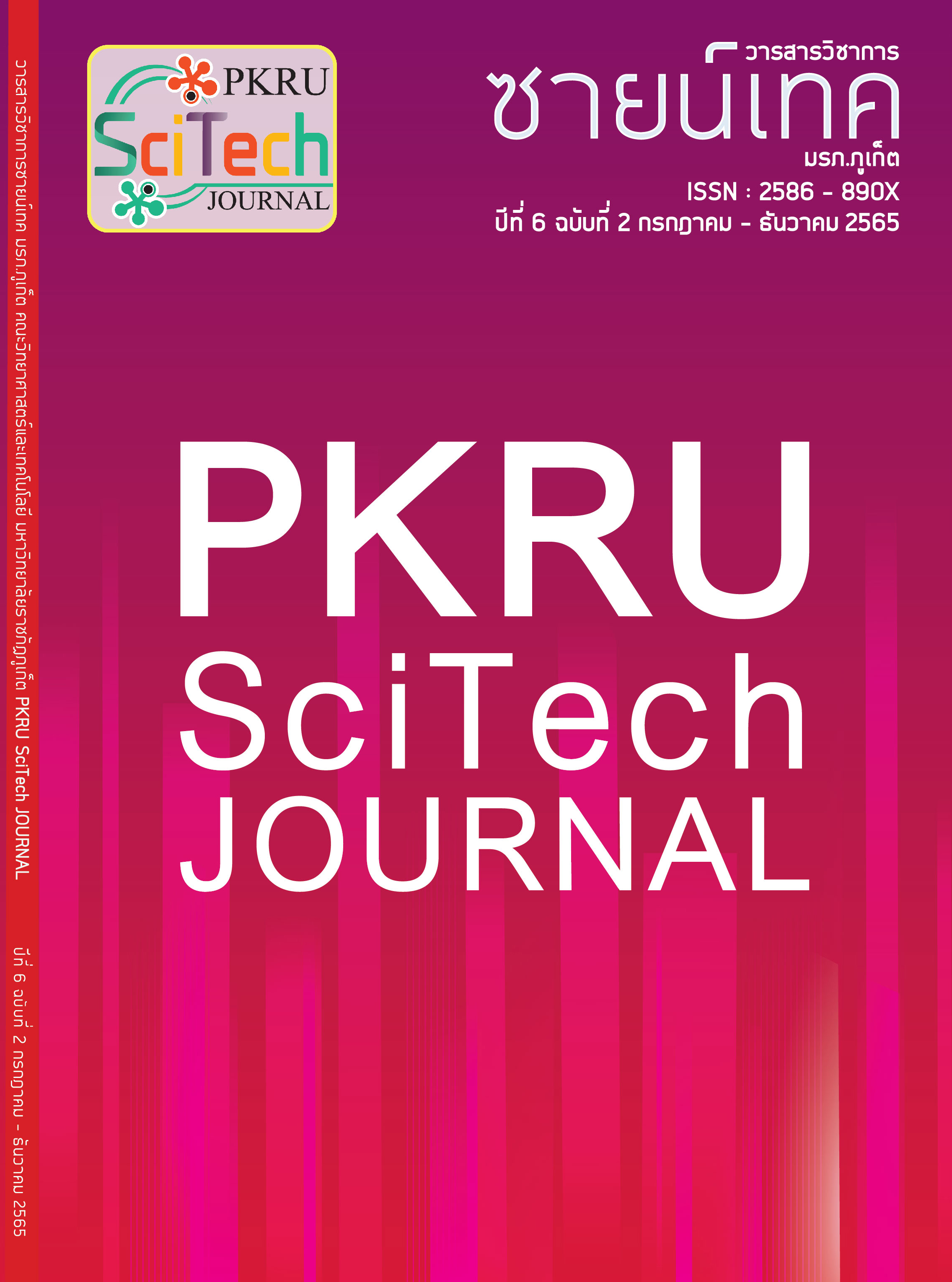Characterization and Development of Foot Scrub from Sarai-Bai-Ma-Kud Halimeda macroloba
Main Article Content
Abstract
Halimeda macroloba is a green seaweed containing high calcium carbonate in its segments. Moreover, H. macroloba contained protein, lipid, carbohydrate, and fiber and was rich in oxygen, carbon, and calcium. For microbial investigation, total aerobic microbial count and total combined fungi and yeasts count is less than 10 colony forming unite (CFU)/g(mL) of autoclave sterilized H. macroloba. These numbers are passed the standard requirements of International Organization of Standardization (ISO) and undesirable specific microorganisms. Escherichia coli, Pseudomonas aeruginosa, and Staphylococcus aureus were not found. The results showed that it has a potential to be used as a scrub in cosmetic products. This study aimed to prepare and characterize foot scrub that made from Konjac flour, chitosan, methyl paraben, cetyl alcohol, stearic acid, propylene glycol, glycerin, aquadest and then mixed with fresh and dried H. macroloba (grain size was around 63 µm). The results showed the foot scrub with dried H. macroloba contained slightly rough texture with dark green, pH = 6 and moisture 35.47±0.64 %. This formula had the highest calcium (Ca) with around 18,850±386 mg/kg compared to formula 1 (no H. macroloba added) and formula 2 (fresh H. macroloba).
Article Details

This work is licensed under a Creative Commons Attribution-NonCommercial-NoDerivatives 4.0 International License.
- The original content that appears in this journal is the responsibility of the author excluding any typographical errors.
- The copyright of manuscripts that published in PKRU SciTech Journal is owned by PKRU SciTech Journal.
References
Coppejans, E., Prathep, A., Leliaert, F., Lewmanomont, K., & Clerck, O. D. (2010). Seaweeds of Mu Ko Tha Lae Tai (1st edition). Bangkok: Biodiversity research and training program.
Pongparadon, S., Zuccarello, G. C., & Prathep, A. (2017). High morpho-anatomical variability in Halimeda macroloba (Bryopsidales, Chlorophyta) in Thai waters. Phycological Research, 65, 136-145.
Mayakun, J., & Prathep, A. (2019). Calcium carbonate productivity by Halimeda macroloba in the tropical intertidal ecosystem: The significant contributor to global carbonate budgets. Phycological Research, 67, 94-101.
Hillis-Colinvaux, L. (1980). Ecology and taxonomy of Halimeda: primary producer of coral reefs. Advances in Marine Biology, 17, 1-327.
van Tussenbroek, B. I., & van Dijik, J. K. (2007). Spatial and temporal variability in biomass and reproduction of psammophytic Halimeda incrassata (Bryopsidales, Chlorophyta) in a Caribbean reef lagoon. Journal of Phycology, 43, 69-77.
Mayakun, J., Liao, C-P., & Liu, S-L. (2020). The standing stock and CaCO3 contribution of Halimeda macroloba in the tropical seagrass-dominated ecosystem in Dongsha Island, the main island of Dongsha Atoll, South China Sea. Journal of the Marine Biological Association of the United Kingdom, 1–9.
Seatan, U., Nontasak, P., Palasin, K., Saelim., Wonglapsuwan, M., Mayakun, J., Pongparadon, S., & Chotigeat, W. (2021). Potential health benefits of fucoidan from the brown seaweeds Sargassum plagiophyllum and Sargassum polycystum. Journal of Applied Phycology, 33, 3357–3364.
Chiarathanakrit, C., Mayakun, J., Prathep A., & Kaewtatip, K. (2019). Comparison of the effects of calcified green macroalga (Halimeda macroloba Decaisne) and commercial CaCO3 on the properties of composite starch foam trays. International Journal of Biological Macromolecules, 121, 71-76.
Boss, C. B., & Fredeen, K. J. (2004). Concepts, Instrumentation and Techniques in Inductively Coupled Plasma Optical Emission Spectrometer (3rd edition). USA: The Perkin-Elmer Corporation.
วลัยพรรณ สุรวัฒนวิเศษ. (2560). การพัฒนาผลิตภัณฑ์ขัดผิวจากเส้นใยสับปะรด [วิทยานิพนธ์ ปริญญาคหกรรมศาสตรมหาบัณฑิต]. กรุงเทพ: มหาวิทยาลัยเทคโนโลยีราชมงคลธัญบุรี.
พงศกร แก้วดี, รังสิมันฌ์จ ชื่นใจ, จิรศักดิ์ ตรีพรหม, ปรียาภรณ์ ไชยสัตย์, และ อมร ไชยสัตย์. (2561). การเตรียมพอลิแอลแลคติกแอซิดไมโครบีดที่มีช่องว่าง โดยเทคนิคอิมัลชันแบบกลับวัฏภาคด้วยการระเหยตัวทำละลายอย่างง่าย. วารสารวิจัยมหาวิทยาลัยเทคโนโลยีราชมงคลธัญบุรี, 17, 41-53.
Ervina, A., Santoso, J., Prasetyo, B. F., Setyaningsih, I., & Tarman, K. (2020). Formulation and characterization of body scrub using marine alga Halimeda macroloba, chitosan and konjac flour (pp 1-9). In IOP Conf. Series: Earth and Environmental Science, 414 012004.
Hou, X., & Yan, X. (1998). Study on the concentration and seasonal variation of inorganic elements in 35 species of marine algae. The Science of the Total Environment, 222, 141-156.
มะลิ วิโรจน์แสงทอง. (2563). ขีดจำกัดจุลินทรีย์ในเครื่องสำอาง. วารสารเภสัชศาสตร์อีสาน, 17, 1-12.


